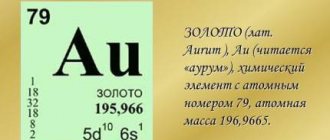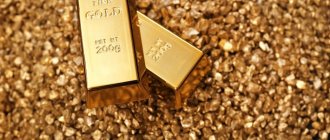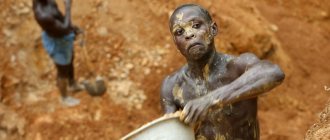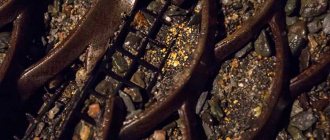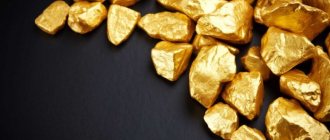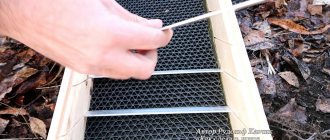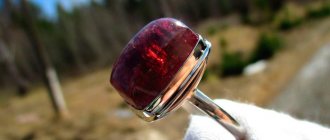Gold is found in minute amounts in almost all rocks that make up the earth's crust. It would seem that humanity should literally go crazy and try to extract this metal by any means. But, as it turned out, this is very expensive, and the costs of searching for it and extracting it from the rock will not be compensated by the amount of yellow substance obtained. To be convincing, we present the following fact: in one ton of rock you can find only 5-6 grams of the precious substance. The only good news is that in different types of ore its concentration may not be the same.
Pure gold
Often the precious metal is found precisely in quartz veins, where industrial deposits have been located for a long time. But even there, the amount of gold mined is much less than other useful metals located in the same place. Therefore, gold mining is considered a very labor-intensive process, which in complexity is second only to the extraction of expensive and rare platinum from ore.
Today there is a theory according to which there is several hundred times more gold in the earth's core. This is explained by the fact that iron-containing meteorites falling to the ground contain this metal in an amount equal to 5-6 grams per ton. Since the Earth’s core is also iron-containing, it is quite reasonable to assume that there are gold reserves there too.
Gold dust
Types of gold deposits
Gold deposits occur mainly in areas of granitoid
, a small number of them are associated with basic and ultrabasic rocks.
Gold forms industrial concentrations in post-magmatic, mainly hydrothermal
, deposits.
Under exogenous conditions, visible gold is a very stable element and easily accumulates in placers
.
However, submicroscopic gold, which is part of sulfides
, upon oxidation of the latter, it acquires the ability to migrate in the oxidation zone.
As a result, gold sometimes accumulates in the zone of secondary sulfide enrichment, but its maximum concentrations are associated with accumulation in the oxidation zone, where it is associated with hydroxides of iron
and
manganese
.
Migration of gold in the oxidation zone of sulfide deposits occurs in the form of bromide
and
iodide
compounds in ionic form.
Some scientists allow the dissolution and transfer of gold with ferric oxide sulfate
or in the form of a suspension suspension.
They differ:
- primary gold deposits,
- placers into which it falls as a result of the destruction of ore deposits
- and deposits with complex ores in which gold is extracted as a by-product.
Indigenous gold and placers
Gold ores and placers are natural mineral formations, the content and total amount of gold in which are sufficient for the economically viable extraction of this metal. Gold is found in ores mainly in native form. It is not chemically pure, but is a solid solution with other metals, mainly silver. In addition, gold in ores is present in the form of tellurides (calaverite AuTe2, etc.), but they are not of great industrial importance. Gold deposits are divided into primary and alluvial.
Primary gold deposits
Primary deposits are represented by veins, vein systems, deposits and zones of veinlet-disseminated ores of various sizes and shapes. Ore bodies are confined to cracks, zones of crushing and shearing of rocks. Their thickness is from 0.05 to tens of m, their length is tens and thousands of m. The largest zones are: the Kolar vein zone in India (length 20 km, developed to a depth of 3.2 km, with an average thickness of the veins 1.2 m), the system lived Mather Lode in the USA (length 200 km); some vein zones of the Yenisei Ridge, mineralized zones of the Muruntau deposit in Central Asia. Gold deposits are known in fold belts, on platforms and in areas of tectonic activation.
Gold ore deposits were formed in different geological eras (from Precambrian to Cenozoic), at different depths (from tens of meters to 4-5 km from the earth's surface), usually in connection with large faults in the earth's crust, forming the so-called. gold belts. Their origin is associated mainly with the activity of hydrothermal waters. The mineral composition of gold ores is varied: quartz and iron sulfides (pyrite, marcasite) predominate, less often arsenic (arsenopyrite); there are sulfides and sulfosalts of copper, lead, zinc, bismuth, antimony, silver, oxides, carbonates. According to the composition and conditions of formation, the following formations are distinguished: 1) gold-sulfide-quartz, represented by quartz veins and streaks containing from 0.5 to 30% sulfides; gold is small and large (nuggets are also found), unevenly distributed, its content ranges from 10-50 to 1000 g/t (USSR, Canada, USA, Brazil, India, Commonwealth of Australia, Ghana, Southern Rhodesia); 2) essentially sulfide, represented by deposits, zones of veinlets and disseminated mineralization; finely dispersed gold, its content rarely exceeds 1-2 g/t, is extracted along with other metals - copper, zinc, lead, nickel (Tanzania, Namibia, Canada, Mexico, Australia).
Oxidation zones of ores (iron hats) of some copper-pyrite and polymetallic deposits are enriched with gold redeposited from primary ores and are independent objects for the extraction of the latter. Most of these deposits are located in the USSR (in the Urals and Kazakhstan).
Gold placers
Gold placers are gold-bearing loose (less commonly cemented) deposits of clastic material formed as a result of the destruction of bedrock deposits and gold-bearing rocks. According to the conditions of formation, the following main types of placers are distinguished: eluvial, deluvial, alluvial, coastal, marine and lacustrine. Alluvial placers, including modern riverbeds, valleys and terraces, as well as ancient buried ones, are of the greatest industrial value. The length of placers is from 1-3 to 25 km, rarely up to 50 and 100 km, with a width from 1 m to 200-300 m, sometimes up to 1 km or more; thickness 1-3m. Gold content is from tenths of g/m3 to tens of kg/m3. Gold placers were formed in different geological eras. Ancient placers are often buried under younger sediments and lie at a depth of 100-150 m from the surface of the earth. The richest gold placers are known abroad - in Canada (the basin of the Yukon and Klondike rivers), the USA (Alaska, California), Colombia, the Commonwealth of Australia, New Zealand, New Guinea, the Philippines; in the USSR (the basins of the Yenisei, Lena, Bodaibo, Vitim, Aldan, Kolyma, Yana and Indigirka rivers).
A special type of gold deposits is metamorphosed placers.
(gold-bearing conglomerates, less commonly gravelites). This type includes the world's largest gold deposit, the Witwatersrand in South Africa. (Source - https://studbooks.net/2401163/matematika_himiya_fizika/korennye_mestorozhdeniya_zolota)
Areas of application
According to statistics, almost all reserves of the extracted substance are used as gold reserves, which are listed on the balance sheet of the state. Most are kept in commercial banks as deposits and investments. A certain percentage is owned by private individuals who mine or collect jewelry, antiques or money. Only 10% of the total amount is used in industry to create equipment, clothing, furniture and other general consumer items.
If we take electrical engineering, gold is used to make an insulating coating for contacts, inputs and connectors, and is also used as solder. Many metals can be carefully gold-plated to protect against corrosion and bacterial damage. This substance is also considered a food additive, so it can be used in the food industry.
If someone didn’t know, then you can’t do without this substance even when creating ordinary glasses. A thin film is made from it, which is a protective layer against infrared radiation. And if an electric charge is passed through this film, the glass will acquire useful anti-fog characteristics. Such glass is used to create ships, cars, aircraft, steam locomotives and other vehicles.
The substance is also used to make dentures for teeth, as well as crowns. It is added to some medications. The material can be found in many cosmetic products that are designed to rejuvenate and improve skin condition. But, as already mentioned, most of the money is spent on creating jewelry, which may differ in size, shape, quality, purpose and cost.
The description provided in this article will help you learn about the characteristics and properties of the valuable mineral gold.
Types of gold ores
Gold is found 1) in all endogenous genetic types of ore deposits (with the exception of pegmatites), 2) in two types of exogenous ( weathering
and
placer
), as well as 3) in metamorphosed deposits. Hydrothermal, placer and metamorphosed deposits are mainly of industrial importance.
Gold ores are natural mineral formations containing gold in quantities at which it is economically feasible to extract it using modern production methods.
In addition to the actual gold ores
Gold-bearing ores
of copper, nickel, lead and zinc, silver, iron (ferruginous quartzites), and manganese, in which gold is an associated component, are known
There are (as mentioned above) endogenous
[underground],
exogenous
[surface] and
metamorphosed
gold ores.
Endogenous gold ores
All [probably, more accurately, most?] endogenous gold ores of hydrothermal
origin. They contain Au from 2-3 to several hundred g/t. They form massive plate-shaped veins (deposits of the Urals, eastern Transbaikalia, Kazakhstan in the CCCP, Porcupine and Kirkland Lake deposits in Canada, Ashanti in Ghana), saddle-shaped veins (deposits of eastern Siberia in the CCCP, Bendigo in Australia), deposits and pipe-shaped bodies of veinlet and stockwork ores (deposits of Uzbekistan in the CCCP, Homestake in the USA).
The composition of [endogenous?] gold ores is varied (up to 200 different minerals). Gold-sulfide-quartz ores predominate (ore minerals from 1.5 to 20%). The main vein mineral is quartz
.
Calcium and iron carbonates, barite, chlorite, sericite, and tourmaline are present in variable quantities. Among the ore minerals,
pyrite
most often predominates ,
and arsenopyrite
. They are subject to pyrrhotite, sulfides and occasionally occurring sulfosalts of copper and lead, zinc, bismuth, silver, iron oxides, native silver, bismuth, and in isolated cases - tellurides.
Hydrothermal gold deposits are quite common. All of them are multi-stage. Divided into plutonogenic
and
volcanogenic
. Plutonogenic associated with granitoid batholiths. They are characterized by ores of relatively simple quartz composition.
Hydrothermal high temperature deposits
Hydrothermal high-temperature deposits of the gold-arsenopyrite formation occur among granitoids and Precambrian metamorphic rocks. The ore bodies consist of quartz veins with visible gold and sulfides, as well as pyritized and silicified zones in the host rocks. Fine, difficult-to-recover gold inclusions are associated with arsenopyrite, pyrite and other sulfides (deposits of the Urals, Kolar in India, etc.). Deposits of this type are widespread.
Hydrothermal medium-temperature deposits
Hydrothermal medium-temperature deposits of quartz-sulfide and gold-quartz formations are represented by veins occurring within massifs of Paleozoic granitoids and in the host sedimentary rocks of the roof. The ores are composed of quartz, carbonates, barite and sulfides - pyrite, chalcopyrite, sphalerite, galena, fahlores, etc. Gold is present in native form in quartz and as an impurity in sulfides. This genetic type is widespread and has great industrial significance. In the CIS it includes some deposits of the Urals, Kazakhstan, Transbaikalia, etc., abroad - the Maternal Shila and Grass Valley deposits in the USA, Kalgoorlie in Australia, deposits in Ghana, Kenya, etc.
Hydrothermal low-temperature deposits
Hydrothermal low-temperature deposits of the gold-silver formation occur in effusive rocks and are spatially associated with areas of young volcanism. Ore bodies are represented by veins and stockwork zones formed at shallow depths. Mineralization is uneven, clustered (bonanza).
The ores contain chalcedony-like quartz, calcite, rhodochrosite, barite, adularia, sulfides, silver minerals, silver gold, and gold tellurides. Examples include the deposits of Transbaikalia and North-East Russia; abroad - Komstock, Goldfield, etc. in the USA, El Oro in Mexico, deposits in Chile, Peru, New Zealand, Indonesia, Japan, Romania, etc. In addition to gold, silver is extracted from ores.
Exogenous gold ores
Exogenous gold ores are contained in placers
, less often - in oxidation zones of gold-bearing sulfide deposits. In placers, gold ores are represented by loose and weakly cemented near-surface deposits that form ore layers and streams (eastern regions, the Urals and others in Russia, California, the Columbia and Yukon river basins, the Klondike River in Alaska in the USA, southern tributaries of the Amazon River, Brazil, etc. ).
Weathering deposits
Weathering deposits are represented by iron and lead caps of sulfide deposits, in which gold accumulates together with iron hydroxides, lead carbonates, and secondary silver minerals. Gold is released in the form of films in caverns and leaching cells. Sometimes, under conditions of free growth, crystals form.
Examples include iron caps of pyrite deposits in the Urals, Balkans, Japan, etc., oxidation zones of polymetallic deposits in Transbaikalia, etc.
Gold placers
Placer gold deposits continue to play a significant role as gold mining targets. The most common alluvial placers containing gold. Alluvial placers, in accordance with the conditions of occurrence, are divided into channel, valley
and
terraced
.
Channel and valley rivers were formed in Quaternary time. They are common in the basins of the Lena, Kolyma, Aldan, Amur, Yenisei and other rivers. Terrace placers formed earlier than valley ones and lie on longitudinal terraces. They are small in size, but the gold content in them is richer than in valley placers. Terrace placers are located in the Lensky district, Aldan, and Kolyma. Rich eluvial gold placers are known in Australia (Kalgoorlie district), where they are a product of lateritic weathering of gold-bearing quartz veins.
Marine placers are found along the seashores. They are formed due to the destruction of quartz veins and ancient coastal placers, poor in gold. The length of the Nome sea placer (Alaska) is 5 km, width 80-100 m. The gold content in the placer is in some places 200 g/t. Buried placers are widely developed. For example, the Jurassic placers of the Urals are buried under marine sediments of Cretaceous age or continental sediments of the Cenozoic; placers of Quaternary age in the North-East and Siberia are covered by glacial deposits.
Metamorphosed gold ores
Metamorphosed gold ores are associated with layers of gold-bearing conglomerates, less commonly gravelites
(Witwatersrand in South Africa, Tarkwa in Ghana, Jacobina in Brazil and Nallaghain in Australia, etc.). Gold in the form of grains, sometimes semi-rounded (size from 5 to 100 microns), is enclosed in quartz-sericite-chlorite cement, as well as in the form of thin veins cutting quartz pebbles. Manifested together with oxides and sulfides of iron and other metals. Au content 3-20 g/t, fineness above 900.
Metamorphosed deposits are represented by gold-bearing conglomerates - a product of transformation of ancient placers, mainly Precambrian. An example is the unique Witwatersrand gold conglomerate deposit in South Africa. However, geological conditions similar to those of the African shield are known on ancient shields of the East European and Siberian platforms, where Precambrian oligomictic and monoquartz conglomerates are recorded. The problem of identifying industrial deposits of gold-bearing conglomerates is of great practical interest.
Extraction of gold from ore and its subsequent processing
Open method of gold mining
Gold deposits are developed using open and closed methods. open pits are quarries in which drilling and blasting operations are carried out to create ore dumps, which are subsequently transported to mining and processing enterprises; closed - these are mines leading to underground deposits from which gold ore is extracted.
Closed mining method
The second is more expensive, since the operation of the mechanisms in the mine requires additional energy, special mechanisms and equipment, and the cost of paying for dangerous working conditions for miners.
Ore processing
Ore processing consists of grinding it to the smallest fractions (into sand) and adding cyanide solution to them.
Interesting: Why is Christmas on January 7th? Reasons, photos and videos
Ore processing
This substance leaches gold particles, the rock settles, and the gold is released and removed along with cyanide from the rock mass. Cyanide leaching can be of two types: with ore grinding, as described above, and heap leaching. In the second option, the ore is not crushed, but cyanide is poured onto the rock pieces.
Getting gold
This process of gold separation is longer, and the share of gold produced from ore is much lower than in the first option. If 95% of the total gold contained in ore can be extracted from the sand fraction, then only 65% can be extracted from rock pieces. The advantage of heap leaching is the lower cost of the treatment process.
Gold minerals
More than 30 gold-containing minerals have been discovered in nature.
Of these, 15 are gold minerals:
- native gold with admixtures of silver, copper, etc.,
- electrum Au and 25-45% Ag,
- porpesite AuPd,
- cuprous gold,
- bismutaurite (Au, Bi),
- native gold,
- iridescent gold,
- platinum gold
- golden silver - kustelite
(Au approx. 10-20%) - and others
The remaining gold-bearing minerals are represented by gold tellurides
:
- calaverite AuTe2 (40-43% Au),
- krennerite (Au, Ag)Te2 (approx. 40% Au),
- sylvanite (Au, Ag)Te4 (25-27% Au),
- petzite Ag3AuTe2 (25% Au),
- mutmanite (Ag, Au)Te,
- montbraite Au2Te3,
- nagiagite Pb5AuSbTe3S6
.
Gold is characterized by native
form.
Among its other forms, it is worth noting electrum
- an alloy of gold and silver, which has a greenish tint and is relatively easily destroyed when transferred by water.
In rocks, gold is usually dispersed at the atomic level. In deposits it is often enclosed in sulfides
and
arsenides
.
Native gold is of primary industrial importance
, secondary -
kustelite
and tellurides:
calaverite
,
krennerite
,
sylvanite
,
petzite
.
Very rare are cuproauride
- AuCu2,
rhodite
- Au, Rh,
porpecite
- Au, Pd,
aurostibite
- AuSb2,
maldonite
- Au2Bi, gold sulfide
uytenbogardeite
- Ag3AuS2, etc. Associated components of gold ores themselves - Ag, Cu, Pb, Zn, Bi, As, Sb, Te, Hg, W, Sn, Co, Ni.
In nature, there is a natural alloy of gold and silver called electrum. When developing ore deposits of solar metal, accompanying valuable chemical elements are extracted from the rock: iridium; platinum; osmium; ruthenium; palladium; nickel; copper.
Native gold
| Native gold is a natural solid solution of Au + Ag. The silver content in native gold is up to 10%. There are signs of discontinuity in this series: significantly different prevalence of native gold of different grades (prevalence 930-900, 820-780, 650-600, extreme rarity - 550) to golden silver - the so-called. kustelita . Characteristic is the phase heterogeneity of native gold individuals with separation of phases of the composition Ag, Ag3, Au, AgAu. Native solar metal is not a chemically pure material; it always contains impurities: silver (up to 50%); copper (up to 20%); gland; mercury; bismuth; platinum group metals; tellurium Common impurities are Cu (0.001-0.9%), Fe, Mn, Pb, less commonly Bi, Sb, Hg, Te, Se, Pt, In, etc. (0.00n - 0.n%). With increased amounts of impurities, varieties of native gold (mostly rare) are distinguished: cuprous gold, bismuth gold, iridium gold, platinum gold, etc. Natural amalgams of Au are known. Impurities of Ag, Fe and others are often concentrated in the growth zones of native gold individuals and along the boundaries of grains or in their individual areas. Native gold contains inclusions of carbon dioxide and other gases. The composition of native gold depends on the type and depth... |
Gold producing countries
Gold is not mined in all countries. This is due to the rarity of this element in nature, as well as the complexity of industrial extraction technologies. There are few open deposits in Russia, mostly closed mines, and our country is a leader in them (4th place).
Previously, the most gold-producing countries were the USA and Canada, then China became the vanguard (it produces about 13% of the world's reserves). The list of the main gold-mining countries is as follows - China, Australia, South Africa, USA, Russia, Peru, Uzbekistan.
